中国饮食文化(英文版)
中国饮食文化 英文版

Thirdly, racial culture is influential to food culture. People in South C hina tend to be more careful and sensitive than northern people. As a result, their dishes as well as appearance are really cute and attr active. Just like dim sum, which means ―touch the heart‖, is one of t he most famous Cantonese meal. It consists of a variety of delicaci es and is usually served for breakfast or dinner.
Secondly, South China is one of the most developed areas in China . It welcomes people from the entire world. As a result, Sothern Cui sine, especially Guangdong Cuisine, emphasizes a flavor which is clear but not light, refreshing but not common, tender but not crude. In summer and autumn it pursues clarity and in winter and spring, a little more substance.
The food with Chinese characteristics
中国饮食文化——英文版
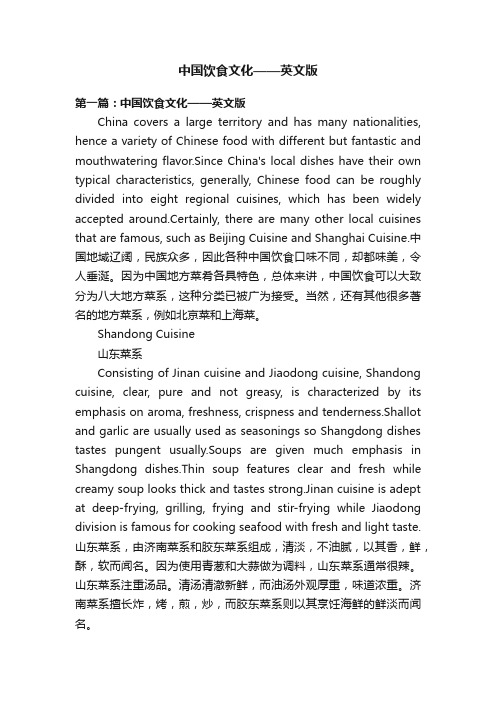
中国饮食文化——英文版第一篇:中国饮食文化——英文版China covers a large territory and has many nationalities, hence a variety of Chinese food with different but fantastic and mouthwatering flavor.Since China's local dishes have their own typical characteristics, generally, Chinese food can be roughly divided into eight regional cuisines, which has been widely accepted around.Certainly, there are many other local cuisines that are famous, such as Beijing Cuisine and Shanghai Cuisine.中国地域辽阔,民族众多,因此各种中国饮食口味不同,却都味美,令人垂涎。
因为中国地方菜肴各具特色,总体来讲,中国饮食可以大致分为八大地方菜系,这种分类已被广为接受。
当然,还有其他很多著名的地方菜系,例如北京菜和上海菜。
Shandong Cuisine山东菜系Consisting of Jinan cuisine and Jiaodong cuisine, Shandong cuisine, clear, pure and not greasy, is characterized by its emphasis on aroma, freshness, crispness and tenderness.Shallot and garlic are usually used as seasonings so Shangdong dishes tastes pungent usually.Soups are given much emphasis in Shangdong dishes.Thin soup features clear and fresh while creamy soup looks thick and tastes strong.Jinan cuisine is adept at deep-frying, grilling, frying and stir-frying while Jiaodong division is famous for cooking seafood with fresh and light taste.山东菜系,由济南菜系和胶东菜系组成,清淡,不油腻,以其香,鲜,酥,软而闻名。
中国饮食文化__英文版
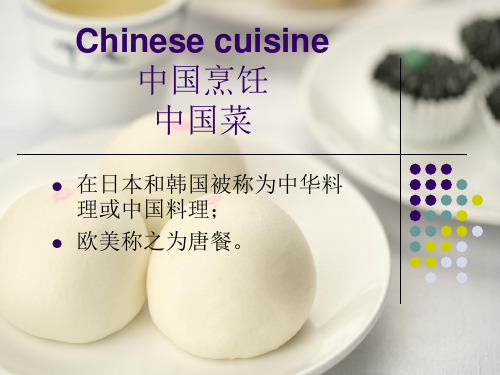
Husband and wife’s slung slice 夫妻肺片
夫妻肺片,原名“夫妻废片”,但并不用肺。属 于川菜系,四川汉族特色小吃,以牛头皮、牛心、 牛舌、牛肚、牛肉为料,注重选料,制作精细, 调味考究。夫妻肺片片大而薄,粑糯入味,麻辣 鲜香,细嫩化渣。深受群众喜爱,为区别于其他 肺片,便以“夫妻肺片”称之,在用料上更为讲 究,质量日益提高。
国菜五品
色--
color 香-- flavor 味– taste 形– shape 意-- meaning
Feature of cooking (烹饪要点)
选材 ingredients 刀工 cutting technique 火候 heat control 调味 flavor
Eight Culinary Traditions of China 八大菜系
Hui Cantonese Min Hunan Su Lu chuan Zhe
徽菜 粤菜 闽菜 湘菜 苏菜 鲁菜 川菜 浙菜
Ridiculous translation
Rolling donkey
Anhui cuisine
Anhui cuisine is derived from the native cooking styles of the Huangshan Mountains region in China and is similar to Jiangsu cuisine, but with less emphasis on seafood and more on a wide variety of local herbs and vegetables. Anhui province is particularly endowed with fresh bamboo and mushroom crops.
Chinese Food 中国饮食文化 英文版
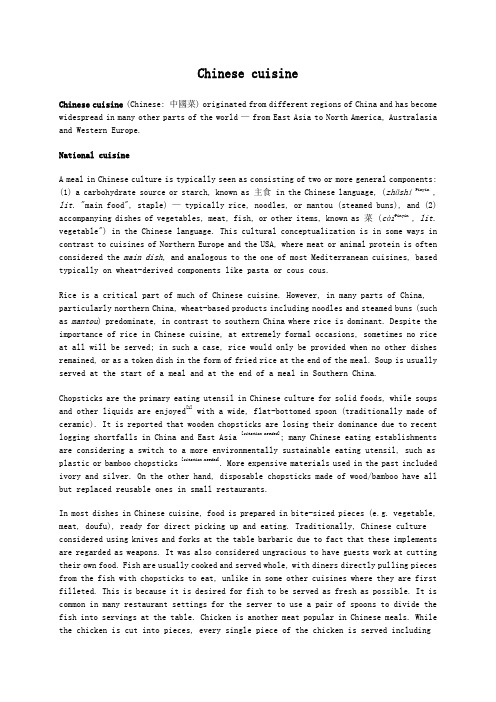
Chinese cuisineChinese cuisine(Chinese: 中國菜) originated from different regions of China and has become widespread in many other parts of the world —from East Asia to North America, Australasia and Western Europe.National cuisineA meal in Chinese culture is typically seen as consisting of two or more general components:(1) a carbohydrate source or starch, known as 主食 in the Chinese language, (zhǔshíPinyin , lit. "main food", staple) — typically rice, noodles, or mantou (steamed buns), and (2) accompanying dishes of vegetables, meat, fish, or other items, known as 菜 (cài Pinyin , lit. vegetable") in the Chinese language. This cultural conceptualization is in some ways in contrast to cuisines of Northern Europe and the USA, where meat or animal protein is often considered the main dish, and analogous to the one of most Mediterranean cuisines, based typically on wheat-derived components like pasta or cous cous.Rice is a critical part of much of Chinese cuisine. However, in many parts of China, particularly northern China, wheat-based products including noodles and steamed buns (such as mantou) predominate, in contrast to southern China where rice is dominant. Despite the importance of rice in Chinese cuisine, at extremely formal occasions, sometimes no rice at all will be served; in such a case, rice would only be provided when no other dishes remained, or as a token dish in the form of fried rice at the end of the meal. Soup is usually served at the start of a meal and at the end of a meal in Southern China.Chopsticks are the primary eating utensil in Chinese culture for solid foods, while soups and other liquids are enjoyed[1] with a wide, flat-bottomed spoon (traditionally made of ceramic). It is reported that wooden chopsticks are losing their dominance due to recent logging shortfalls in China and East Asia [citation needed]; many Chinese eating establishments are considering a switch to a more environmentally sustainable eating utensil, such as plastic or bamboo chopsticks [citation needed]. More expensive materials used in the past included ivory and silver. On the other hand, disposable chopsticks made of wood/bamboo have all but replaced reusable ones in small restaurants.In most dishes in Chinese cuisine, food is prepared in bite-sized pieces (e.g. vegetable, meat, doufu), ready for direct picking up and eating. Traditionally, Chinese culture considered using knives and forks at the table barbaric due to fact that these implements are regarded as weapons. It was also considered ungracious to have guests work at cutting their own food. Fish are usually cooked and served whole, with diners directly pulling pieces from the fish with chopsticks to eat, unlike in some other cuisines where they are first filleted. This is because it is desired for fish to be served as fresh as possible. It is common in many restaurant settings for the server to use a pair of spoons to divide the fish into servings at the table. Chicken is another meat popular in Chinese meals. While the chicken is cut into pieces, every single piece of the chicken is served includinggizzards and head. The emphasis in Chinese culture on wholeness is reflected here. It is considered bad luck if fish or chicken is served without its head and tail, as that is synonymous with something that does not have a proper beginning or end.In a Chinese meal, each individual diner is given his or her own bowl of rice while the accompanying dishes are served in communal plates (or bowls) that are shared by everyone sitting at the table. In the Chinese meal, each diner picks food out of the communal plates on a bite-by-bite basis with their chopsticks. This is in contrast to western meals where it is customary to dole out individual servings of the dishes at the beginning of the meal. Many non-Chinese are uncomfortable with allowing a person's individual utensils (which might have traces of saliva) to touch the communal plates; for this hygienic reason, additional serving spoons or chopsticks (公筷, mon/public/shared chopsticks) may be made available. In areas with increased Western influence, such as Hong Kong, diners are provided individually with a heavy metal spoon for this purpose. The food selected is often eaten together with some rice either in one bite or in alternation.Vegetarianism is not uncommon or unusual in China, though, as is the case in the West, it is only practiced by a relatively small proportion of the population. The Chinese vegetarians do not eat a lot of tofu, unlike the stereotypical impression in the West. Most Chinese vegetarians are Buddhists. Chinese vegetarian dishes often contain large varieties of vegetables (e.g. pok choy, shiitake mushroom, sprouts, corn) and some "imitated meat". Such "imitated meat" is created mostly with soy to imitate the texture, taste, and appearance of duck, chicken, or pork. Chinese Buddhist cuisine has many true vegetarian dishes that contain no meat at all.In contrast to most western meals, a Chinese meal does not typically end with a dessert. However, a sweet dish is usually served at the end of a formal dinner or banquet, such as sliced fruits or a sweet soup (糖水, lit. sugar water) which is served warm.In traditional Chinese culture, cold beverages are believed to be harmful to digestion of hot food, so items like ice-cold water or soft drinks are traditionally not served at meal-time. Besides soup, if any other beverages are served, they would most likely be hot tea or hot water. Tea is believed to help in the digestion of greasy foods. Despite this tradition, nowadays beer and soft drinks are popular accompaniment with meals. A popular combo in many small restaurants in parts of China is hot pot served with cold beer, a combination known as 冷淡杯 (Pinyin: leng3 dan4 bei1, literally: cold and bland cup, despite being strongly flavored), which is the very opposite of what traditional wisdom would admonish. Ideas from Chinese herbology, such as the four natures, influence the food combinations favored in traditional Chinese meals.Common dishes found on a national levelThere are many dishes that are considered part of the nation's national cuisine today. Below are lists of a few of the more common dishes available in China on a national level.Dishes by ingredientPoultry-based dishes•Kung Pao chicken (gongbao jiding) 宫保鸡丁•Peking Duck (Beijing kaoya) 北京烤鸭 - the trademark dish of Beijing•Soy egg (滷蛋; lǔdàn): hard boiled egg,•Tea egg (茶葉蛋; (cháyèdàn): hard boiled egg•Century egg (皮蛋; pi2 dan4; lit. leather egg):1 thousand year old eggPork-based dishes•Dongpo pork (Donpo rou)东坡肉•Sweet and sour pork (gulaorou) 古老肉•Twice Cooked Pork (huiguorou) 回锅肉•Char siu (chashao) 叉烧 (Barbecued roast pork)Grain-based dishesRice-based dishes•Rice 米饭o Fried rice (chaofan) 炒饭Noodles•Noodles 面条o Fried noodles (chowmein) 炒面o Noodle soup 面汤o Zha jiang mian (zhajiangmian) 炸醬面 - noodles mixed with a heavily flavored meat sauceLegume-based dishes•Doufu 豆腐 with•Mapo doufu 麻婆豆腐•Soy milk (豆奶; dou4 nai3 or 豆漿; dou4 jiang1) in either sweet or "salty" form •Stinky tofu (choudoufu) 臭豆腐•Fermented cabbage (酸菜)Vegetable-based dishes•Buddha's delight (luohanzhai) 罗汉斋 (vegetarian dish popular amongst Buddhists) •Pickled vegetables (jiangcai) (醬菜; jiang4cai4; lit. sauced vegetables)Dishes by cooking method•Double boiling/Double steaming 炖 - is a Chinese cooking technique to prepare delicate and often expensive ingredients. The food is covered with water and put in a covered ceramic jar, and is then steamed for several hours.•Red cooking 紅烧 - an umbrella term used to describe slow-cooked stews characterized by the use of soy sauce and/or caramelized sugar and various ingredients.•Stir-fry - an umbrella term used to describe two fast Chinese cooking techniques: chǎo (炒) and bào (爆).Dumplings•Jiaozi 饺子(steamed (zhengjiao) or boiled (shuijiao, tangjiaozi) dumplings) •Wonton (huntun) 馄饨/云吞 (sphere-shaped dumplings usually served boiled in broth or deep-fried)•Guotie 锅贴(fried jiaozi dumplings)•Xiao Long Bao (xiaolongbao) 小笼包(soup dumplings) - a specialty of Shanghai •Dim sum (dianxin) 点心 - a staple of Cantonese cuisine•Zongzi 粽子(glutinous rice wrapped in bamboo leaves, usually with a savory or sweet filling)•Baozi 包子 (filled steamed buns)•Mantou (steamed bun) 馒头Pastry•Mooncake (yuebing) 月饼 (special cake eaten at Mid-Autumn Festival)•Shaobing 烧饼 - a flaky baked or pan-seared dough pastry.•Youtiao 油条 - "oily tail", or other fried Chinese doughfoods饼(including green onion pancakes (congyoubing) 葱油饼)•Sachima 沙琪玛 - a sweet pastry commonly sold in Oriental convenience stores •Longevity buns (steamed buns filled with bean paste, made to look like peaches and served on birthdays)Soups, stews and porridge•Hot pot 火锅•Hot and sour soup (suanlatang) 酸辣汤•Congee (粥; zhou1): rice porridge•Tong sui (tangshui) 糖水 (sweet Cantonese soup served as a dessert)•Won ton soupChinese FoodFood has a special meaning to the Chinese people. The "waste not, want not" ethos means that a surprising range and variety of plants and animals, and every part of a plant or animal is used. This has given rise to a remarkable diversity in the regional cuisine, but to Westerners it can be overwhelming - surprising, fantastic, delicious, horrifying or disgusting - and above all, different.Chinese Cooking ArtChinese cooking embodies the dining culture tradition of Chinese nation. Compared with the cooking of all other nations in the world, it has many distinctive features.Firstly, it has varied flavor. Since our country has a vast territory and abundant resources with differences in climate, products, customs and habits in all parts, it has developed many flavors in diet over a long period of time. There has been the saying of rice in the south and noodles in the north in our country all the time. The flavor is divided into sweetness in the south, saltiness in the north, sourness in the east and hotness in the west, which can mainly be reduced to the four flavors of Bashu (Sichun), Qilu (Shandong), Huaiyang (Jiangsu) and Yuemin (Guangdong and Fujian).Secondly, there are differences in four seasons. With four seasons in a year, people take food according the seasons, which is another feature of Chinese cooking. Since antiquity, our country has always seasoned and matched food with the variation of seasons. The flavor is pure and thick in winter while light and cool in summer. The food are mostly braised, stewed, simmered in winter and cold and dressed with sauce and frozen in summer.Thirdly, it places an emphasis on aesthetic feeling. Chinese cooking has not only superior techniques, but also has the tradtion of placing an emphasis on the aesthetic feeling of dishes and pays attention to the harmony and agreement of food’s color, fragrance, flavor, shape and utensils. The aesthetic feeling of dishes has all around representations. Whether it is a red radish or a green cabbage, all kind of designs can be carved out, which has a unique style, attains the harmony of color, fragrance, flavor, shape and beauty and provides people with highly unified special enjoyment in spirit and material.Fourthly, it pays attention to temperament and interest. The cooking of our country has placed an emphasis on taste and interest since very early times. It not only has strict requirements on the color, fragrance and flavor of meals and snacks, but also has certain requirements on the naming of dishes, the manner of tasting the flavor, the rhythm of having dinner and the insertion of entertainment, etc. The names of Chinese dishes can be called reaching the aceme of perfection and suiting both refined and popular tastes. The dishes may named realistically according to the main ingredients, supplementary ingredients and seasoning as well as their cooking methods or called in accordance with historical literaryquotations, myths, legends, the intereting episodes of celebrities taking food, the image of dishes, such as "family collections (made of all sorts of seafood and riverfood)", "red lion's head (fried meatballs in brown sauce)", "beggar's chicken" (roasted chicken in yellow mud).Lastly, it combines food with medicine. The cooking technique of our country is closely related with medical treament and health care. There has been the statement that food and medicine have the same origin and action since several thousand years ago. It takes advantage of the medicinal properties of the raw materials of food and makes them into all kinds of cuisine, thereby accomplishing the purpose of preventing and curing certain diseases.Chinese Food and Health BuildingThroughout Chinese history people have searched for a way to achieve immortality. Huang Di. the Yellow Emperor. was the legendary forefather of all tribes in the Central Plains. He was well versed in medicine. language. philosophy. and mathematics. There is a Chinese myth that in remote ages Huang Di rode a dragon into heaven.Emperors of later dynasties. from Shi Huang. the founding emperor of the Qin Dynasty. to Wu Di. the emperor of the Han Dynasty. hoped to turn this myth into reality. They either sent virgins of both sexes to the East China Sea for the elixir of life. or blindly trusted necromancers and worshipped ghosts and gods in search of a way to become immortal. The Chinese theory of health building developed from efforts to protect and build health. prevent disease. and prolong life. The I Ching (Book of Changes). a Confucian classic written more than 2.000 years ago. says: "If accustomed to the nature of Heaven and Earth. man can live forever even if he gets sick."The philosophical writings of thinkers and statesmen from the late years of the Spring and Autumn Period contain many descriptions about health building. These writings include the Dao De Jing by Lao Zi. the Analects of Confucius and the Guan zi of Guan Zhong. These were the start of Chinese theories on health building.The Spring and Autumn and Warring States Periods (770 �C 221 B.C.) were a fertile time for multiple schools of thought. and political pluralism provided a rich atmosphere for developing academic thought. Representatives of all schools of thought were concerned with political issues and problems related to life. As life is inseparable from food and drink. scholars of the pre �C Qin times contemplated dietetic culture and the relationship between food and health building.Energy of foodsTraditional Chinese Medicine classifies foods by their energetic values rather than their caloric or fat content. Here is a list of popular foods and their classification.COLD Banana Watermelon Bok Choi Turnip Celery Califlower CrabBean Sprouts Asparagus Eggplant Cucumber Grapefruit Pineapple Tangerine Zucchini Seaweed Tofu COOLPearPeppermintGreen TeaOolong TeaBitter GourdCookedLettuceGreen AppleSnow PeaWhite CornOrangesCabbageSoybeanSproutsApplesCooked OnionStrawberriesCheeseCherriesMushroomsMisoWARMRiceNoodlesBreadPorkChickenTurkeyBroccoliGreenPepperGreen BeansEgg WhitesYellow CornEgg YolkFishPepperGingerGarlicCookedTomatoSpinachBlack TeaNectarinesMilkHOTNutsGrilledFoodsAvocadoLicheeTurtleChocolateCocoaRaw OnionsCoffeeLambDuckEggplantRed PepperVenisonDeep FriedFoodsChinese Cooking TechniquesSuperior MaterialsMaterial selection is the first and foremost technique for Chinese chefs and the basis for making top grade Chiense cuisine. It requires rich knowledge and skilled techiniques of application. The raw materials of each cuisine include main ingredients, side ingredients, supplementary ingredients and seasonings, which all need careful study and have fixed patterns. They can be generalized as the two words of "exquisiteness" and "fineness". This is what Confucius says high quality materials and finely cut meat. “Exquisiteness” means when selecting materials, people should consider the characteristics of their varities, places of origin, seasons and growth period, etc. Superior materials should be fresh, rich, tender, and excellent in quality. Take Beijing roasted duck as example. It selects the "stuffed duck" produced in Beijing. An exellent quality duck has a weight around two and a half kilograms. If it is too large, the flesh will be old while if it is too small, the flesh will not be fat and delicious enough. Sometimes materials need special treatment according to the flavor of dishes. Take the famous dish of Hangzhou "West Lake fish in vinegar" as example. It selects live grass carp produced by the West Lake. Though it tasets fresh, it has loose flesh and the smell of earth. Therefore, it should be placed in a specially made bamboo cage and starved for two days in clear water until its flesh become solid and the odor of earth is got rid of. In this way, the fish will taste more tender and delicious with the flavor of crab flesh after being cooked. "Fineness" means selecting raw materials from the best part. For example, the famous cuisine "chicken cubes with peanuts" selects the tender flesh at the breast of a spring chicken of the same year so as to guarantee the tenderness of flesh.Fine Slicing TechniquesSlicing technique is namely the cutting treatment of a chef on raw materials of food so that the materials might have an orderly and identical shape required by cooking, adapt to duration and be heated evenly. In this way, the materials become tasty while retaining certain morphological beauty. Therefore, it is one of the keys of cooking techniques. Our country has attached great importance to the application of slicing techniques since ancient times. Through repeated practice, chefs of past dynasties have created abundant ways of cutting, such as straight cutting, slice cutting, oblique cutting, score cutting (score the material without cutting off) and engraving cutting, process raw materials into all shapes such as slice, strip, shred, pieces, diamond, grain, paste, into a variety of designs and colors such as pellet, ball, ear of wheat, Lizi, coir raincoat, orchid and chrysanthemum.Cutting techniques are combined with dish decoration. Ripe materials and edible raw materials can be pieced together into highly artistic and lifelike hors d'oeuvres of birds, beasts, insects, fish, flower, grass, such as "dragon and phoenix bringing auspices and prosperity (made of snakes, hens, hams and medlars)", "peacock showing its tail (steamed bream with scallions and black beans)", "a pied magpie ascending the plumb tree (made of sautéed goose breast, stewed winter mushroom with gravy, white cake, yellow cake, ripe chicken breast, carrot and ham, etc)", "lotus and crane (made of lotus, egg, shark fin and crab roe)" and "two phoenixes above flower basket". For example, "peacock showing its tail" uses fifteen ingredients such as duck meat, ham, pig tongue, partridge egg, crab claw meat and cucumber and is completed through twenty two exquisite cutting techniques and decorating procedures.Original DurationDuration is one of the keys to the formation of the flavor characteristics of delicious dishes. However, duration is fast changing, it is difficult to control the duration to perfection without several years of practical operational experience. Hence, a mastery of appropriate duration is a stunt of the chefs in our country. The chefs in our country can accurately distinguish between different firepower such as vigorous fire, medium fire and slow fire, are familiar with the heat-resistant degree of all kinds of ingredients, are skillful in controlling the time of using fire, excel in mastering the performance of heat transfer objects (oil, water and gas), fix on the sequence of placing ingredients into the boiler according to the ingredients’ degree of tenderness, amount of water, shapes, sizes, wholeness and thickness and apply cooking techniques flexibly. Hence, the cooked dishes can either be tender, soft or boiled to a mush.Duration is the most important thing in cooking and also the most difficult to be mastered and explained. However, whether a cook can become a famous chef, the key lies in duration. Therefore, when cooks in the cuisine field of our country operate duration, they bring into full play the abilities of subtle observation and experience and rich imagination with a lifetime's experience and intelligence of enlightening themselves and do the creation of diet culture. Ingenuity in varying tactics depends on mother wit. It’s really the ca se that "the gain and loss can be known to the cook's heart".Five Flavors Being in Harmonious ProportionFlavoring is an important cooking technique. "If five flavors are in harmonious proportion, there will be a hundred sweet-smelling flavors". The flavors of fish and meat dishes are divided into the basic type and the compoud type. The basic type is probably divided into nine categories, namely, saltiness, sweetness, sourness, spiciness, bitterness, freshness, fragrance, numbness and lightness. The compound type is difficult to be counted. It can generally be reduced to around fifty types. The flavor types of dishes in our country approximately include: salty and flesh flavor, salty and sweet flavor, sour and sweet flavor, spicy and salty flavor, fragrant and spicy flavor, spicy flavor, fragrant rice wine flavor, fish flavor and special spicy flavor, etc.Eight Distinct Regional CuisineChinese dishes have many schools in cooking. Of them, the most influential and representative and acknowleged by the society are the culinary schools of Lu, Chuan, Yue, Min, Su, Zhe, Xiang and Hui, namely, what people often says "the eight culinary schools" of China.The formation of a culinary school is inseparable with its long history and original cooking characteristics. It is also under the influences such as natural geography, climatic conditions, resources, specialties and dieting habits of this area. Someone decribes "the eight culinary schools" with personalized devices: the cuisines of Jiangsu and Zhejiang are compared to delicate and pretty beauties of the Yangtze River Delta; those of Shandong and Anhui are compared to clumsy and simple sturdy man of the north; those of Guangdong and Fujian are compared to dissolute and elegant childes; those of Sichuan and Hunan are like the personage with abundant and substantial connotations and varied accomplishment. The cooking techniques of Chinese "eight culinary schools" have their own charm and the characteristics of dishes also have their own strong points.Lu CuisineLu cuisine is composed of Jinan cuisine, Jiaodong cuisine and Kongfu cuisine. Though the three cuisines have the same geographical position and belong to the category of "Lu cuisine", they have their own characteristics.Jinan cuisine selects materials extensively. The dishes with thick color are particular about being bold and unconstrained. Moreover, the strong point of Jinan cuisine lies in making soup. The use and making of clear soup, milky soup and superior soup all have strict stipulations. The famous snacks of Jinan include Wuren Stuffed Bun (a bun stuffed with five kernels of walnuts, peanut, ginkgo, melon seeds and sesame), Large Stuffed Bun of the Spring City, Spring Cake and Spring Rolls with shepherd’s purse herb, etc.Jiaodong cuisine, which includes dishes in Qingdao, Yantai and Weihai, excels in making seafood. The cooking method of Jiaodong cuisine is particular about freshness, aliveness and insipidity and its flavor gives priority to tenderness. Famous snacks include sauce olla podrida, baked sleeve-fish, stir-fried clam, frozen vegetables and green-bean starch noodles and Chinese fried dumpling. Of them the Chinese fried dumplings have twenty to thirty flavors.Kongfu cuisine, which is represented by "high quality materials and finely cut meat" of Confucius, is composed of the two categories of banquet catering and daily homemade meals. The Kongfu banquet has different specifications in accordance with the rank of monarch, minister, father and son, uses the whole set of silver tablewares and serves 196 courses of dishes.Representative dishes:Fish in sweat and sour sauce, braised pig elbow, fried mutton slices with green scallion, braised sea cucumbers with spring onions, baked bean curd, braised whelk with brown sauce and fried oysters, etc.Chuan CuisineIn late Qin and early Han period, Chuan cuisine had basically been established. During the Tang and Song Dynasties, it went through rapid development. In the Ming and Qing Dynasties,it had enjoyed a great reputation. Now the Chuan cuisine restaurants spread all over the world. Authentic Chuan cuisine is represented by the dishes of Chengdu of Sichuan Province and Chongqing. It attaches importance to material choice and is particular about specifications. The side dishes distinguished by different colors have a clear distinction between primary and secondary priority, thus being bright-colored and harmonious. It is characterized by sourness, sweetness, numbness, spiciness, fragrance, heavy oil and thick flavor. Placing an emphasis on seasoning, it can't go without chilli, pepper and Chinese red pepper as well as fresh ginger. It wins universal praise for its hotness, sourness and numbness, which are rare in other local dishes, develop the unique flavor of Chuan cuisine and enjoys a good reputation as "one dish with one flavor and one hundred dishes with one hundred flavors". Its cooking methods excel in baking, sautéing, dry-sauteeing and steaming. Chuan cuisine is good at using flavor and has thick gravy. Based on the five flavors of saltiness, sweetness, numbness, spiciness and sourness, it is added with all kinds of seasonings, which cooperate with each other and develop into twenty three compound flavors of all sorts, such as homemade flavor, salty and fresh flavor, fish flavor, litchi flavor and bizarre flavor, etc.Representative Dishes:Braised chicken dices with peanuts, sautéed spicy pork, boiled beef in hot sauce, Mapo dofu (spicy bean curd), fried sliced pork meat with spicy sauce and fish with bean sauce, etc.Yue CuisineThere have been records of Yue cuisine since the West Han Dynasty. During the South Song Dynasty, it was under the influence of the migration of imperial chefs to the lamb city (Guangdong). During the Ming and Qing Dynasties, it went through rapid development. In the 20th century, due to international trade, it assimilated some strenghs of western food and hence was spread all over the world. There are several thousand of Yue cuisine restaurants in New York of America. Yue cuisine develops with the dishes of Guangzhou, Chaozhou and Dongjiang as representatives. The cuisine has extensive raw materials, a great variety of designs and colors, novel shapes. It is changeable and particular about freshness, tenderness, refreshingness and smoothness. Generally it strives to be light in summer and autumn and lay particular stree on thickness and pureness in winter and spring. Seasoning has the dinction between five tastes (fragrance, softness, stinkiness, fatness and thickness) and six flavors (sourness, sweetness, bitterness, saltiness, spciness and freshness). Its cooking excels in frying, deep-frying, braising, stewing, and sautéing, etc. The dishes have thick colors and taste smooth without being greasy.。
中国传统饮食文化英文版
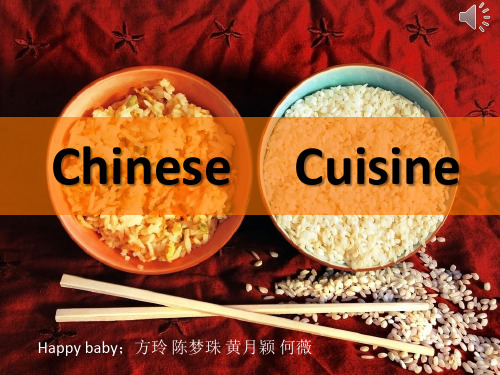
HappyBaby
陈梦珠
PPT demonstration
Poster
Content
• Happy • baby
1.Group introduction
•2.Topic introduction
3.conclusion
Topic introduce
The traditional staple food. The traditional festival food Eight regional cuisines Table manners
On the fifth day of the fifth lunar month, the Dragon Boat Festival, zongzi, or glutinous rice cake wrapped in reed leaf is the festivity food. The Dragon Boat Festival has had more than 2,000 years of history in China.
•
事实上,中国北方人常说,广东人 吃天上飞的,除了飞机;地上爬的,除 了火车;水里游的,除了船儿。
•
• ZheJiang Cuisine 浙江菜系
Comprising local cuisines of Hangzhou, Ningbo and Shaoxing, Zhejiang Cuisine, not greasy, wins its reputation for
freshness, tenderness, softness, smoothness of its
dishes with mellow fragrance. Hangzhou
中国饮食文化中英文
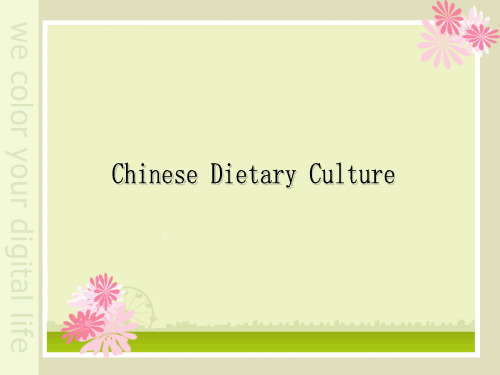
wishes and pursuit of hope, and commemorate the
ancestors.
Spring Festival
Dumplings Fish
Wonton 馄饨
New Year cake
Lantern festival and Mid Autumn Festival
Dietary practices of celebration
The birth of the children, the birthday of the olds and the marriage are important moments for celebration, though the size can’t compare with the National festivals, they reflect the customs of life with a strong local color. 孩子的出生,生日和结 婚庆典 等 重要时刻,尽管规模比不上国家节日,它们 也反映了强烈的地方生活的特色。
rice glue ball /sweet dumpling元宵
moon cake
The round shape indicates reunite and
happiness, and people eat them to denote union, harmony and happiness for the family.圆形表示团聚 和快乐,人们吃它们表示联盟,和谐和幸福的家庭。
In traditional Chinese culture and education in the philosophy of yin and yang, the Confucian ethical concepts, theory of traditional Chinese medicine nutrition regimen, as well as cultural and artistic achievements, food aesthetic fashion, national character traits under the influence of many factors to create the annals of the Chinese cooking skills, the formation of extensive and profound Chinese food culture. 在中国传统文化和教育哲学的阴 阳,儒家伦理概念,中医理论营养方案,以 及文化和艺术成就,食物的审美时尚,民族 性格特征的影响下许多因素创造中国烹 饪技能上,形成博大精深的中国饮食文化
中国饮食文化 英文版
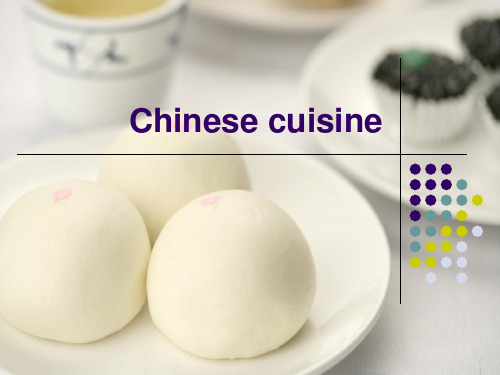
李鸿章杂烩
相传公元1896年,李鸿章奉旨到俄国参加皇 尼古拉二世 的加冕典礼,顺道访问欧美。一路上吃了两个多月的西餐, 胃口都吃倒了,所以一到美国就叫使馆的厨师用中国徽宴 请美国宾客。曾宴请美国宾客,因中国菜可口美味,深受 欢迎,连吃几个小时洋人还不肯下席。此时总管向他禀告: “中堂大人,菜已吃完,怎么办?”李鸿章略加思索后说: “把撤下去的残菜混在一起加热,用大盆端上来”。不一 会儿,热气腾腾的菜端上桌,洋人尝后连声叫好,便问菜 名,李鸿章一时答不上来,只是说:“好吃多吃!”岂料 歪打正着,“好吃多吃”与英语杂烩(Hotchpotch)发音 相近,后来此菜便被命名为“李鸿章杂烩”。” 另一种说法是:李命厨师加菜,但正菜已上完,厨师 只好将所剩海鲜等余料混合下锅,烧好上桌,外宾尝后赞 不绝口,并询问菜名,李用合肥话说:“杂碎”(即杂烩 谐音)。此后,“大杂烩”便在美国传开,合肥城乡也仿 而效之,遂成名菜。
Chinese cuisine
What do you know about Chinese cuisine ?
The world's three largest kingdom of cuisine
Turkey cuisine
French cuisine
Chinese cuisine
People regard food as their prime want 民以食为天
国菜五品
色--
color 香-- flavor 味– taste 形– shape 意-- meaning
Feature of cooking
选材 ingredients 刀工 cutting technique 火候 heat control 调味 flavor
中国饮食文化 英文 (2)
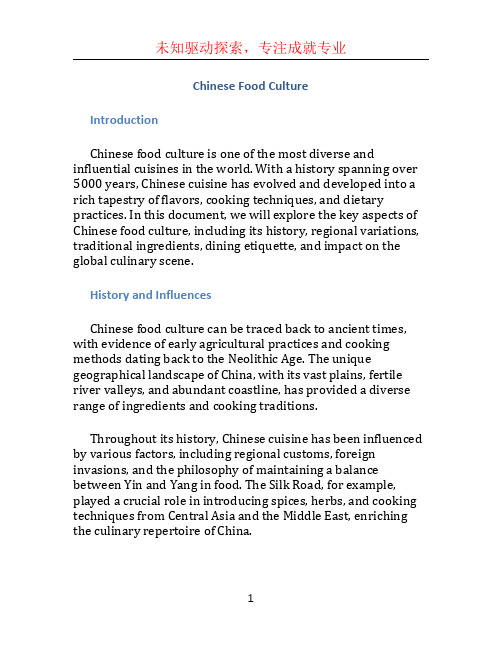
Chinese Food CultureIntroductionChinese food culture is one of the most diverse and influential cuisines in the world. With a history spanning over 5000 years, Chinese cuisine has evolved and developed into a rich tapestry of flavors, cooking techniques, and dietary practices. In this document, we will explore the key aspects of Chinese food culture, including its history, regional variations, traditional ingredients, dining etiquette, and impact on the global culinary scene.History and InfluencesChinese food culture can be traced back to ancient times, with evidence of early agricultural practices and cooking methods dating back to the Neolithic Age. The unique geographical landscape of China, with its vast plains, fertile river valleys, and abundant coastline, has provided a diverse range of ingredients and cooking traditions.Throughout its history, Chinese cuisine has been influenced by various factors, including regional customs, foreign invasions, and the philosophy of maintaining a balance between Yin and Yang in food. The Silk Road, for example, played a crucial role in introducing spices, herbs, and cooking techniques from Central Asia and the Middle East, enriching the culinary repertoire of China.Regional VariationsChina is a vast country with diverse regional cuisines, each with its own unique flavors and characteristics. The Eight Great Traditions of Chinese cuisine include Sichuan, Shandong, Cantonese, Jiangsu, Fujian, Hunan, Anhui, and Zhejiang cuisines. Each region’s cuisine is shaped by factors such as climate, geography, local produce, and cultural traditions.For instance, Sichuan cuisine is known for its bold and spicy flavors, often incorporating the use of Sichuan peppercorns and chili peppers, while Cantonese cuisine emphasizes freshness and subtle flavors, with a focus on seafood and stir-frying techniques. These regional variations showcase the immense diversity of Chinese food culture.Traditional Ingredients and TechniquesChinese cuisine is characterized by its use of fresh, seasonal ingredients and a wide array of cooking techniques. Traditional ingredients such as rice, wheat, soybeans, and tofu are staples in Chinese cooking. Herbs and spices, such as ginger, garlic, star anise, and five-spice powder, are used to enhance flavors and create balance in dishes.Cooking techniques in Chinese cuisine are diverse and varied, including stir-frying, steaming, braising, and deep-frying. These techniques aim to preserve the natural flavors and textures of the ingredients while ensuring optimal nutritional value.Dining EtiquetteDining etiquette is an integral part of Chinese food culture. Traditional Chinese meals are often shared among family members and enjoyed in a communal setting. Here are some key aspects of dining etiquette in Chinese culture:1.Chopstick Etiquette: Chopsticks are the primaryutensils used in Chinese dining. It is considered impolite to stab food with chopsticks or leave them standing vertically in a bowl, as these actions resemble funeral rituals.2.Order of Dishes: In a Chinese meal, dishes areserved in a specific order. Soups and cold dishes aretypically served first, followed by stir-fried and braiseddishes, and finally, rice or noodles.3.Bowl and Plate Etiquette: It is customary to holdthe rice bowl close to your mouth while eating from it, but never use your chopsticks to point at others or to spearfood from shared dishes. Instead, use serving spoonsprovided.4.Toast and Cheers: In Chinese culture, toasting is acommon way to show respect and build camaraderie. When toasting, it is customary to hold your glass lower than those of higher-ranking individuals and make eye contact during the toast.Chinese Cuisine’s Global ImpactChinese cuisine has had a significant impact on the global culinary scene. As Chinese immigrants settled in different partsof the world, they brought their culinary traditions and introduced them to new cultures. Today, Chinese restaurants can be found in nearly every major city worldwide, offering a taste of authentic Chinese flavors and dishes.Moreover, Chinese ingredients and cooking techniques have influenced other cuisines, leading to the creation of fusion and East-West culinary styles. Popular dishes such as sweet and sour pork, General Tso’s chicken, and dim sum have become international favorites, showcasing the global appeal of Chinese food culture.ConclusionChinese food culture is a testament to the rich culinary heritage and diversity of China. Its history, regional variations, traditional ingredients, dining etiquette, and global impact make it an integral part of not only Chinese society but also the world at large. By exploring and appreciating Chinese food culture, we can gain a deeper understanding of the traditions, flavors, and values that have shaped this ancient cuisine.。
中国饮食文化 英文版

Eight Culinary Traditions of China 八大菜系
Chinese dishes may be categorized as one of the Eight Culinary Traditions of China, also called the "Eight Regional Cuisines" and the "Eight Cuisines of China".
李鸿章杂烩
相传公元1896年,李鸿章奉旨到俄国参加皇 尼古拉二世 的加冕典礼,顺道访问欧美。一路上吃了两个多月的西餐, 胃口都吃倒了,所以一到美国就叫使馆的厨师用中国徽宴 请美国宾客。曾宴请美国宾客,因中国菜可口美味,深受 欢迎,连吃几个小时洋人还不肯下席。此时总管向他禀告: “中堂大人,菜已吃完,怎么办?”李鸿章略加思索后说: “把撤下去的残菜混在一起加热,用大盆端上来”。不一 会儿,热气腾腾的菜端上桌,洋人尝后连声叫好,便问菜 名,李鸿章一时答不上来,只是说:“好吃多吃!”岂料 歪打正着,“好吃多吃”与英语杂烩(Hotchpotch)发音 相近,后来此菜便被命名为“李鸿章杂烩”。” 另一种说法是:李命厨师加菜,但正菜已上完,厨师 只好将所剩海鲜等余料混合下锅,烧好上桌,外宾尝后赞 不绝口,并询问菜名,李用合肥话说:“杂碎”(即杂烩 谐音)。此后,“大杂烩”便在美国传开,合肥城乡也仿 而效之,遂成名菜。
Eight Culinary Traditions of China 八大菜系
Hui Cantonese Min Hunan Su Lu chuan Zhe
徽菜 粤菜 闽菜 湘菜 苏菜 鲁菜 川菜 浙菜
Ridiculous translation
中国饮食文化-英文版
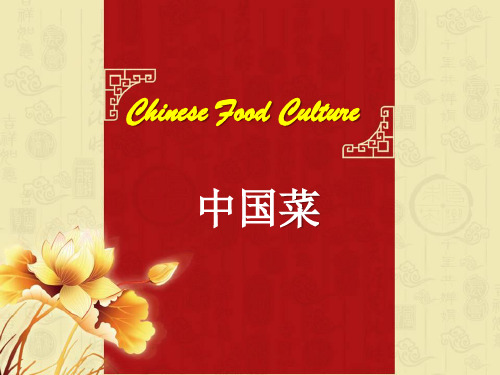
One of the oldest cuisines in China, with a history of 2,500 years. Originates from Confucius family banquet, then adopted by imperial kitchen. Lu cai has great influence in north China and has become the representative of North China cuisines
Cuisine feature
Ingredients: •Maize(玉米) •PeanutsGrains(谷物) •Staple vegetables •Vinegar(醋) Taste characteristics • •Salty, Fresh, Original • •Stir fried, Fire power • •Soup, Seafood • •Plentiful and • substantial
Features:
• Focus on the temperate of cooking • Good at braising and stewing.
Turtle soup with ham
Min cuisine 闽菜
•Min cuisine is one of the native Chinese cuisines derived from the native cooking style of Fujian province.
Hui Cuisine 徽菜
Distribution: Anhui province Delicacy :
•Good at steaming and stewing
中国饮食文化中英文

Exquisite cooking skills
Knife craftsmanship
Chinese chefs are skilled at using various knife techniques to cut ingredients into different shapes and sizes, in order to enhance the beauty and taste of dishes.
02
Characteristics of Chinese Food Culture
Diversity of cuisine
Eight cuisines
Local snacks
The eight most famous cuisines in Chinese food culture, including Sichuan cuisine, Shandong cuisine, Guangdong cuisine, Jiangsu cuisine, Zhejiang cuisine, Fujian cuisine, Hunan cuisine and Anhui Cuisine cuisine, have their own characteristics and flavors.
中国饮食文化中英文
汇报人:XX
2024-01-24
• introduction • Characteristics of Chinese Food Culture • Comparison of Chinese and Western Food
Cultures • The Influence of Chinese Food Culture on
VS
中国饮食文化 英文
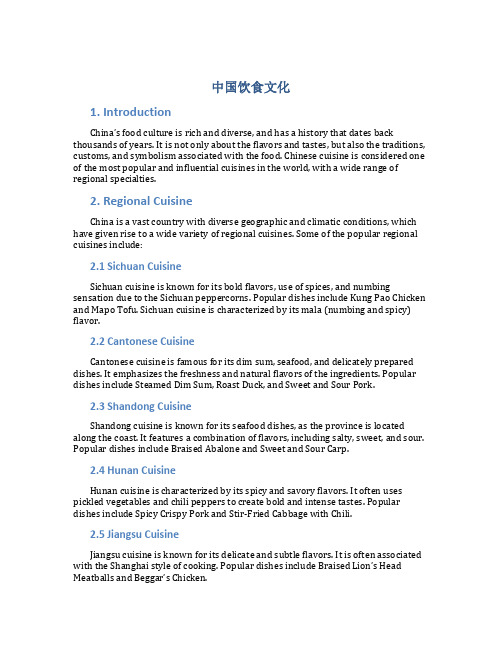
中国饮食文化1. IntroductionChina’s food culture is rich and diverse, and has a history that dates back thousands of years. It is not only about the flavors and tastes, but also the traditions, customs, and symbolism associated with the food. Chinese cuisine is considered one of the most popular and influential cuisines in the world, with a wide range of regional specialties.2. Regional CuisineChina is a vast country with diverse geographic and climatic conditions, which have given rise to a wide variety of regional cuisines. Some of the popular regional cuisines include:2.1 Sichuan CuisineSichuan cuisine is known for its bold flavors, use of spices, and numbing sensation due to the Sichuan peppercorns. Popular dishes include Kung Pao Chicken and Mapo Tofu. Sichuan cuisine is characterized by its mala (numbing and spicy) flavor.2.2 Cantonese CuisineCantonese cuisine is famous for its dim sum, seafood, and delicately prepared dishes. It emphasizes the freshness and natural flavors of the ingredients. Popular dishes include Steamed Dim Sum, Roast Duck, and Sweet and Sour Pork.2.3 Shandong CuisineShandong cuisine is known for its seafood dishes, as the province is located along the coast. It features a combination of flavors, including salty, sweet, and sour. Popular dishes include Braised Abalone and Sweet and Sour Carp.2.4 Hunan CuisineHunan cuisine is characterized by its spicy and savory flavors. It often uses pickled vegetables and chili peppers to create bold and intense tastes. Popular dishes include Spicy Crispy Pork and Stir-Fried Cabbage with Chili.2.5 Jiangsu CuisineJiangsu cuisine is known for its delicate and subtle flavors. It is often associated with the Shanghai style of cooking. Popular dishes include Braised Lion’s Head Meatballs and Beggar’s Chicken.3. Traditional Chinese Food CustomsChinese food customs are deeply rooted in tradition and symbolize various aspects of Chinese culture. Here are some of the common food customs:3.1 Dining EtiquetteChinese dining etiquette emphasizes respect and consideration for others. It is customary to wait for the elders to start eating before others begin. Chopsticks should not be left sticking upright in a bowl, as it is considered impolite.3.2 Lucky FoodsCertain foods are believed to bring good luck and fortune in Chinese culture. For example, fish symbolizes prosperity, and dumplings symbolize wealth and good fortune. These foods are often served during festivals and special occasions.3.3 Festival FoodsChinese festivals are often accompanied by specific food traditions. For example, during the Lunar New Year, a reunion dinner is prepared, which includes dishes with symbolic meanings, such as whole fish for abundance and rice cake for prosperity.4. Modern Chinese CuisineWhile traditional Chinese cuisine remains popular, modern Chinese cuisine has also gained recognition in recent years. Chefs have started experimenting with fusion dishes, incorporating Western ingredients and cooking techniques into Chinese cuisine.5. ConclusionChinese food culture is rich in flavors, traditions, and symbolism. It not only satisfies the taste buds but also reflects the values and beliefs of Chinese society. Whether it is the spicy Sichuan cuisine or the delicate Cantonese dishes, Chinese cuisine continues to captivate people around the world, making it a prominent part of global culinary traditions.Note: This document is written in Markdown format. Markdown is a lightweight markup language that allows for easy formatting and conversion to HTML.。
胡自山中国饮食文化英文版
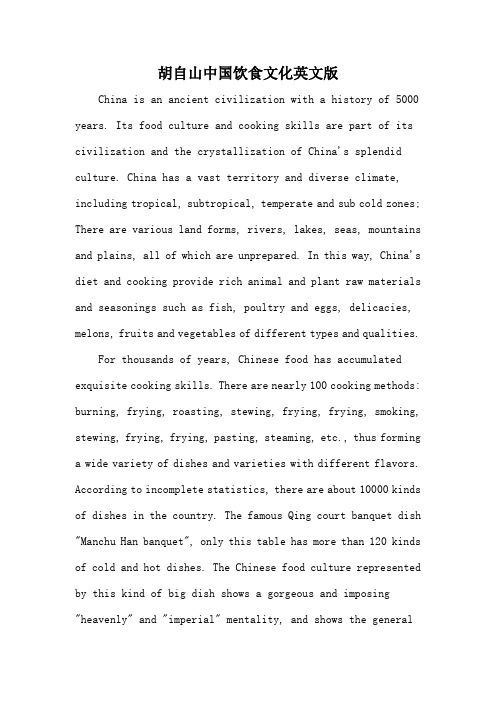
胡自山中国饮食文化英文版China is an ancient civilization with a history of 5000 years. Its food culture and cooking skills are part of its civilization and the crystallization of China's splendid culture. China has a vast territory and diverse climate, including tropical, subtropical, temperate and sub cold zones; There are various land forms, rivers, lakes, seas, mountains and plains, all of which are unprepared. In this way, China's diet and cooking provide rich animal and plant raw materials and seasonings such as fish, poultry and eggs, delicacies, melons, fruits and vegetables of different types and qualities.For thousands of years, Chinese food has accumulated exquisite cooking skills. There are nearly 100 cooking methods: burning, frying, roasting, stewing, frying, frying, smoking, stewing, frying, frying, pasting, steaming, etc., thus forming a wide variety of dishes and varieties with different flavors. According to incomplete statistics, there are about 10000 kinds of dishes in the country. The famous Qing court banquet dish "Manchu Han banquet", only this table has more than 120 kinds of cold and hot dishes. The Chinese food culture represented by this kind of big dish shows a gorgeous and imposing "heavenly" and "imperial" mentality, and shows the generalcharacteristics of Chinese traditional culture.。
- 1、下载文档前请自行甄别文档内容的完整性,平台不提供额外的编辑、内容补充、找答案等附加服务。
- 2、"仅部分预览"的文档,不可在线预览部分如存在完整性等问题,可反馈申请退款(可完整预览的文档不适用该条件!)。
- 3、如文档侵犯您的权益,请联系客服反馈,我们会尽快为您处理(人工客服工作时间:9:00-18:30)。
Tea Culture
China is the homeland of tea and Chinese people loves tea, it is said the history of tea is more than 4700 years since Shennong age. Tea culture means the cultural identity which produced in the process of tea activities, including the tea ceremony, spirit of tea, tea-set, tea painting and so on.
Anhui Cuisine
Rich Breakfast
Chinese people always set a good value to breakfast.
Morning tea Bean milk Fried dough sticks
Staple Food
Rice
Steamed bread
Noodles
Thank you
Sichuan Cuisine
Cantonese food
Cantonese are known to have an adventurous palate, able to eat many different kinds of meats and vegetables.
Consisting of Fuzhou Cuisine, Quanzhou Cuisine and Xiamen Cuisine. Its choice seafood, beautiful color and magic taste of sweet, sour, salty and savory.
Chinese Food
China covers a large territory and has many nationalities, hence a variety of Chinese food with different but fantastic and mouthwatering flavor.
Pancake
Local Flavour Snacks
Hot-Hot-Hot BBQskewers
Stinky tofu
Halogeno-benzene
Delicious seafood stall.
There are shrimps, crabs, scallops, abalone, squid and so many delicious sea food.
Fujian Cuisine
Jiangsu Cuisine
Careful selection of ingredients, its meticulous preparation methodology, and its not-too-spicy, not-too-bland taste.
Comprising local cuisines of Hangzhou, Ningbo and Shaoxing Freshness, tenderness, softnessine
Anhui Cuisine
Shandong cuisine
Consisting of Jinan cuisine and Jiaodong cuisine Hot pot
Clear, pure and not greasy
Dry pot
grilled fish Spicy and pungent prolific of tastes, emphasizes on the use of chili. Pepper
Zhejiang Cuisine
Hunan cuisine
Thick and pungent flavor.
Consists of local Cuisines of Xiangjiang Region, Dongting Lake and Xiangxi coteau.
Anhui Cuisine chefs focus much more attention on the temperature in cooking and are good at braising and stewing.
Chinese food can be roughly divided into eight regional cuisines :
Shandong Cuisine
Sichuan Cuisine
Cantonese Cuisine
Fujian Cuisine
Jiangsu Cuisine
ZheJiang Cuisine
